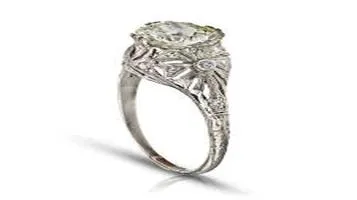A Timeless Elegance: A Review of Edwardian Filigree Rings
Edwardian filigree rings are exquisite pieces of jewelry that reflect the elegance and sophistication of the Edwardian era, spanning from 1901 to 1910. These rings are renowned for their intricate and delicate designs, characterized by fine metalwork and lace-like patterns that showcase the craftsmanship of the time. Typically crafted from platinum or white gold, Edwardian filigree rings often feature intricate openwork, where metal is artistically shaped into detailed scrolls, vines, and floral motifs. The rings often incorporate dazzling gemstones such as diamonds, sapphires, or rubies, enhancing their allure. Known for their lightness and femininity, these rings are timeless heirlooms that capture the romantic essence of an era celebrated for its attention to detail and artistic expression.

The Edwardian era, spanning from 1901 to 1910, was a period of elegance and opulence, which is vividly captured in the jewelry of the time. Among the most exquisite pieces that have endured through the ages are Edwardian filigree rings. These rings are more than just accessories; they are miniature works of art that encapsulate the grace and sophistication of an age long past. This review aims to delve into the intricate beauty, craftsmanship, and historical significance of Edwardian filigree rings, making a case for why they remain a cherished choice for jewelry enthusiasts and collectors alike.
Design and Craftsmanship
The hallmark of Edwardian filigree rings is their intricate and delicate design. Filigree, a technique involving the twisting and curling of fine metal threads to create intricate patterns, is the cornerstone of these rings. The metalwork often features lace-like patterns that are airy and light, yet immensely detailed. This technique requires an exceptional level of skill and precision, a testament to the craftsmanship of the jewelers of the time.
Most Edwardian filigree rings are crafted from platinum, a metal that was both fashionable and practical due to its strength and ability to hold fine details. The use of platinum allowed for the creation of complex designs that would have been impossible with softer metals. Some rings also incorporate gold accents, adding a layer of richness and contrast to the overall design.
Gemstones and Settings
Another defining feature of Edwardian filigree rings is the use of gemstones. Diamonds are a common choice, often set in intricate clusters or as a central solitaire. Old mine cuts and European cuts, with their larger facets and unique sparkle, were popular during this period. These cuts differ from modern diamonds and contribute to the antique charm of the rings.
In addition to diamonds, Edwardian filigree rings often feature colored gemstones such as sapphires, emeralds, and rubies. These vibrant stones are usually set in milgrain bezels or surrounded by smaller diamonds, enhancing their brilliance and adding a pop of color to the intricate metalwork. Pearls were also a popular choice, symbolizing purity and elegance.
Historical and Cultural Significance
The Edwardian era was a time of prosperity and progress, often referred to as the "Belle Époque" or the "Beautiful Age." This period saw a flourishing of the arts, fashion, and culture, influenced by the reign of King Edward VII. The jewelry of the time reflects this sense of luxury and refinement.
Edwardian filigree rings, in particular, embody the era's appreciation for delicate beauty and fine craftsmanship. They were often worn by the upper echelons of society, symbolizing wealth and status. Today, these rings serve as a tangible connection to a bygone era, offering a glimpse into the sophistication and elegance that defined the early 20th century.
Versatility and Modern Appeal
Despite their historical roots, Edwardian filigree rings have a timeless appeal that transcends periods and styles. Their intricate designs and elegant settings make them versatile pieces that can complement both vintage and contemporary wardrobes. Whether worn as an engagement ring, a statement piece, or simply as a cherished heirloom, these rings add a touch of classic elegance to any ensemble.
Moreover, the resurgence of interest in vintage and antique jewelry has brought Edwardian filigree rings back into the spotlight. Modern brides, in particular, are drawn to the unique charm and individuality of these rings. Unlike mass-produced contemporary pieces, each Edwardian ring has its own story and character, making it a truly special choice for those looking for something one-of-a-kind.
Conclusion
Edwardian filigree rings are more than just pieces of jewelry; they are enduring symbols of an era that celebrated beauty, elegance, and meticulous craftsmanship. The intricate designs, high-quality materials, and historical significance of these rings make them a cherished addition to any collection. Whether you are a seasoned collector, a vintage jewelry enthusiast, or someone looking for a unique and meaningful piece, Edwardian filigree rings offer a timeless allure that is hard to resist.
In a world where trends come and go, the enduring beauty of Edwardian filigree rings stands as a testament to the timeless appeal of exquisite craftsmanship and elegant design. As you slip one of these rings onto your finger, you are not just wearing a piece of jewelry; you are carrying a piece of history, a fragment of a beautiful age that continues to inspire and captivate us today.






